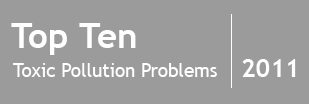Agricultural Production
Pesticide Pollution
Estimated Population at Risk:
2.2 Million
Description
Agricultural production is one of the largest and most important economic activities in the world, particularly in low- and middle-income countries, where agriculture has a significant impact on GDP growth.20 Some of the largest agricultural sectors throughout the world include the production of grain (rice, wheat, corn, etc.), coffee, beans (soy, lentil, etc.), potatoes, and tea. A major factor in agriculture over the last decades is the use of pesticides that protect crops from insects and pests that may be harmful to crop quality and yields. Agrochemicals, which include pesticides, herbicides, and fertilizers, have been widely used since the 1940s in many low- and middle-income countries. Unfortunately, many chemical pesticides, particularly those containing chlorinated compounds, are often persistent in the environment and can be toxic to humans.21 These kinds of pesticides are dangerous to many different forms of life, and their impacts can spread far beyond their production and application point to even a global scale. Chemical pesticides can harm agricultural workers who do not wear the proper safety gear and can also be dangerous for nearby communities. Common pathways for human exposure include inhalation when pesticides are applied (particularly when applied through spraying), ingestion of contaminated foods, ingestion of contaminated soil (particularly children, who may not wash hands before eating after playing in dirt), and contamination of surface or groundwater and subsequent ingestion.
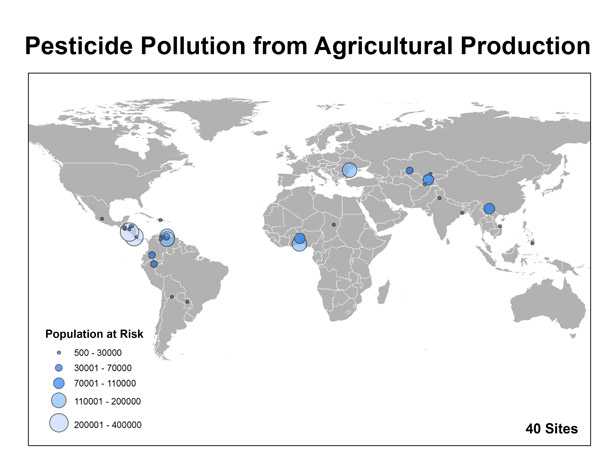
Populations estimates are preliminary and based on an ongoing global assessment of known polluted sites.
Industrial Process
The term “pesticide” describes a category of agrochemicals that are used to protect crops from certain bacteria, insects, and other potentially damaging organisms. Pesticides include insecticides, molluscicides, nematocides, fungicides, and herbicides and are intended to disrupt the ability of certain species to harm crop yields by paralyzing or killing them. Though pesticides have been instrumental in contributing to global agricultural growth, they are often harmful to more than just their target species. Organophosphates and organochlorine pesticides, for example, can cause damage to nervous systems by harming neurotransmitting enzymes and can be ingested by many different types of creatures.
Some organochlorine pesticides, including DDT, lindane, endosulfan, and chlordane, are so disruptive and dangerous that many countries have banned their use and have classified them as Highly Hazardous. Despite the risks associated with pesticide use, many forms of these chemicals are still widely used in low- and middle-income countries in a large variety of agricultural settings and have impacts far beyond the locations where they are sprayed. Studies have found that over 98 % of insecticides used in agricultural processes do not quickly degrade at the point of application and end up entering the larger environment, typically through rain and irrigation runoff, spray carry-over, or residue retention on food.22
Global Context
The use of pesticides worldwide has grown significantly over the past sixty years, with approximately 2.3 million tons of industrial pesticides now used annually. With this boom has come larger crop yields and more secure and reliable food sources for growing populations. Many low- and middle-income countries have even been able to produce enough food to sustain a large agricultural export economy, as well as to better feed their own population. These successes have led to a persistent demand for and use of pesticides. However, the mass application of these agrochemicals has impacted human health depleted agriculture's natural resource base, and jeopardized future productivity. The Food and Agriculture Organization of the United Nations launched “Save and Grow” in 2011 to reduce reliance on pesticides through a sustainable ecosystem approach.23
Many of the world’s agricultural processes take place in rural and economically disadvantaged areas where regulations are lacking and health standards are not enforced. For these reasons, pesticides are often improperly used and stored, and workers are often not fully aware of and protected from the dangers that pesticide exposure and contamination can cause. In addition, due to lax regulations, low cost, and the effectiveness of certain hazardous pesticides, sustained use of banned pesticides is an ongoing problem in many low-income rural areas.24 Thus, agricultural workers and their families are more severely affected by dangerous pesticide chemicals and contamination in these regions than in higher-income countries with tighter regulations.

Countries in South and Central America, where agricultural production is a widespread and yearround activity in many places, are badly impacted by health problems associated with pesticide contamination. One study found high levels of DDT in the breast milk of women who lived near spraying areas in Guatemala and El Salvador, with the highest levels found near cotton fields.25 Pesticide contamination also impacts a large number of people in Central Asia and Eastern Europe. Blacksmith’s ongoing global assessment of polluted sites estimates that over 2.2 million people are at risk from exposure to pesticides from agricultural production. This number, however, is likely significantly smaller than the actual impacted population, since Blacksmith has only performed site assessments for a limited number of locations affected by pesticide use. As Blacksmith continues to collect data and assess more sites around the world, this number will continue to grow.
Exposure Pathways
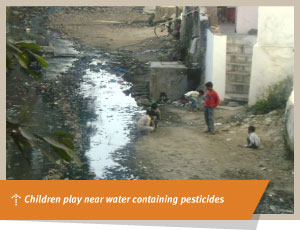 The most common ways that people are exposed to pesticides are through occupational dermal contact and inhalation or ingestion of food or water containing the chemicals. A large number of agricultural workers in low- and middle-income countries do not use protective masks, gloves, or suits while applying pesticides to crops, mostly due to the expense of this equipment. Toxins can be absorbed through the skin during handling of pesticides, can enter the body by touching plants or objects that have been sprayed, and can be inhaled during spraying processes if proper safety precautions are not taken.
The most common ways that people are exposed to pesticides are through occupational dermal contact and inhalation or ingestion of food or water containing the chemicals. A large number of agricultural workers in low- and middle-income countries do not use protective masks, gloves, or suits while applying pesticides to crops, mostly due to the expense of this equipment. Toxins can be absorbed through the skin during handling of pesticides, can enter the body by touching plants or objects that have been sprayed, and can be inhaled during spraying processes if proper safety precautions are not taken.
Pesticides can also reach people who do not directly work in agriculture when large amounts are washed into streams, lakes, oceans, and ground water sources by rain or irrigation. The toxins can then be directly ingested through drinking water or can accumulate in the tissues of a variety of aquatic life. Many of the most widely used pesticides have been classified as Persistent Organic Pollutants (POPs), meaning that they have long life-spans, do not biodegrade well, and have the ability to bio-accumulate in living tissue. When large amounts of pesticides build up in food sources, this contaminates the food chain for nearby communities.
Health Effects
Though there are many different kinds of pesticides, each with its own particular health impacts from a variety of chemicals, common health effects include skin
irritations, respiratory and pulmonary problems, vision loss, damage to nervous and immune systems, birth defects, DNA damage, disruption of the hormonal system, many different forms of cancer, and in some cases, death. A study of over 2,000 agricultural workers in Africa, Asia, and Latin America found that many workers suffered from acute pesticide poisoning and reported the following symptoms: chronic headaches, dizziness, convulsions, and nausea.26
What Is Being Done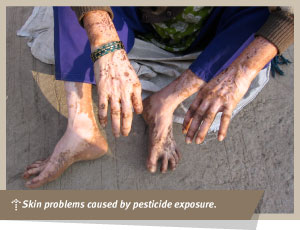
The health problems associated with pesticide contamination and poisoning have been recognized on a global scale. In 2004, the Stockholm Convention on Persistent Organic Pollutants (POPs) entered into force, with the expressed aim of reducing and abolishing production of POPs, including toxic organochlorine-based pesticides.27 The United Nations Food and Agriculture Organization (FAO) is working to introduce and implement more modern forms of agricultural production in order to minimize the amount of pesticides that are currently used on a global scale.
On a more local scale, educational programs that teach farmers about the risks pesticides pose to their health and the safety of their communities have been very successful. These programs are often implemented by local governments with international support. In some cases, retailers of certain pesticide products will offer safety classes in order to ensure the proper and responsible ways to use their products. Other safety programs are offered to farmers by NGOs, such as “Plagbol” (Plaguicidas Bolivianas) in Bolivia, which provides a telephone advice service and training for the proper and safe use of pesticides.28 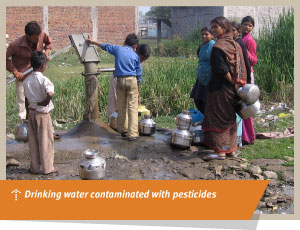
Blacksmith has worked to support programs that develop a set of “best practices” for the application and use of pesticides and that help to implement strategies for reducing pesticide use and storage. Blacksmith also works in impacted areas to help raise funds for training and education programs that teach best practices and identify alternatives to pesticides. Green Cross Switzerland works closely with FAO, UNEP and WHO in the area of the Former Soviet Union and in West-Africa to raise awareness on the risks of old and obsolete pesticides, to find and safeguard old pesticides, to introduce better practices in future pesticides management, and to introduce (non-chemical) alternatives to DDT to control malaria in Central Asia and the Caucasus.
Example – DALY Calculations
The Hugli River in West Bengal, India, is an important source of water for people living near its banks, and the river is used for bathing, drinking, and cooking. This large river breaks off from the Ganges in northeastern India and empties into the Bay of Bengal. The Hugli, however, poses a risk to human health as it is contaminated with high levels of aldrin (an organocholrine) due to heavy pesticide use in the region. Water samples taken near Calcutta found 0.9 micrograms per liter of aldrin in the water – about 30 times the health standard. Blacksmith’s assessment of a town on the banks of the Hugli estimated that 30,000 people were at risk of adverse health impacts from exposure to contaminated water.
DALYs associated with adverse health effects due to aldrin exposure at this site are estimated to be 475 for the estimated exposed population of 30,000. This means that the approximately 30,000 affected people will have a collective 475 years lost to death, or impacted by disease or disability. If spread equally across all impacted persons, this comes out to 0.02 years lost or lived with a disability per person.
Footnotes
[20]: K. Aseno-Okyere, et al. “Advancing Agriculture in Developing Countries through Knowledge and Innovation.” International Food Policy Institute, 2008. Available at: http://www.ifpri.org/sites/default/files/publications/oc59.pdf
[21]: Pesticides only slowly decompose over decades or even centuries.
[22]: Miller, G.T. “Chapter 9.” Sustaining the Earth. 6th ed. Pacific Grove, California: Thompson Learning, Inc., (2004): 211-216.
[23]: See: http://www.fao.org/ag/save-and-grow/.
[24]: Wesseling, C., et al. “Agricultural Pesticide Use in Developing Countries: Health Effects and Research Needs.” International Journal of Health Services, Vol. 27, No. 2 (1997): 273-308.
[25]: de Campos, M. and Olszyna-Marzys, AE. “Contamination of human milk with chlorinated pesticides in Guatemala and in El Salvador.” Archives of Environmental Contamination and Toxicology, Vol. 8, No. 1 (1979): 43-58.
[26]: Pesticide Action Network International. “Communities in Peril: Global Report on Health Impacts of Pesticide Use in Agriculture.” 2010. Available at: http://www.pan-international.org/panint/files/PAN-Global-Report.pdf.
[27]: “About the Convention.” Stockholm Convention on Persistent Organic Pollutants. Available at: http://chm.pops.int/Convention/tabid/54/Default.aspx.
[28]: Jors, E. “Acute Pesticide Poisonings Among Small-Scale Farmers in La Paz County, Bolivia.” Department of International Health, Institute of Public Health, University of Copenhagen, 2004.
Available at: http://plagbol.org.bo/files/tesis%20plagbol%20version%20completa%20en%20ingles.pdf.

-
Artisanal Gold Mining
Mercury Pollution
-
Industrial Estates
Lead Pollution
-
Agricultural Production
Pesticide Pollution
-
Lead Smelting
Lead Pollution
-
Tannery Operations
Chromium Pollution
-
Mining and Ore Processing
Mercury Pollution
-
Mining and Ore Processing
Lead Pollution
-
Lead-Acid Battery Recycling
Lead Pollution
-
Arsenic in Groundwater
Arsenic Pollution
-
Pesticide Manufacturing and Storage
Pesticide Pollution
-
The Rest of the Toxic Twenty

